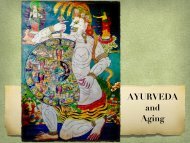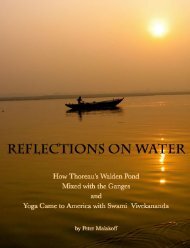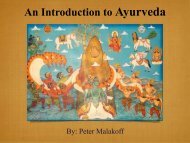How Thoreau's Walden Pond Mixed with the Ganges and Yoga Came to America with Swami Vivekananda
One early morning in 1846, during the coldest days of a New England winter, Henry David Thoreau looked out the window of his small cabin on Walden Pond and saw men cutting its ice into blocks. That ice was hauled by horse to a railroad that ran across the western edge of Walden Pond, packed into a boxcar, taken to Boston and loaded onto a clipper ship that sailed to Calcutta, India, arriving about four months later. Once there, that ice was purchased by grateful members of the East India Company. Thoreau had witnessed a small part of the global ice trade between New England and India that took place during the latter part of the nineteenth century. When Thoreau considered the ice trade, his vision sailed on metaphors far beyond the scope of business. The waters he imagined flowed both east and west and carried not just natural elements, but culture, religion and philosophy as well. He envisioned that after arriving in Calcutta, the New England ice of Walden Pond would eventually melt and run downhill where it would join with the sacred water of the Ganges. He wrote in Walden: "It appears that the sweltering inhabitants of Charleston and New Orleans, of Madras and Bombay and , drink at my well. In the morning I bathe my intellect in the stupendous and cosmogonal philosophy of the , since whose composition years of the gods have elapsed, and in comparison with which our modern world and its literature seem puny and trivial; and I doubt if that philosophy is not to be referred to a previous state of existence, so remote is its sublimity from our conceptions. I lay down the book [Bhagavad-Gita] and go to my well for water, and lo! there I meet the servant of the Bramin, priest of and and who still sits in his temple on the Ganges reading the , or dwells at the root of a tree with his crust and water jug. I meet his servant come to draw water for his master, and our buckets as it were grate together in the same well. The pure Walden water is mingled with the sacred water of the Ganges." This book tells the story of these waters . . .
One early morning in 1846, during the coldest days of a New England winter, Henry David Thoreau looked out the window of his small cabin on Walden Pond and saw men cutting its ice into blocks. That ice was hauled by horse to a railroad that ran across the western edge of Walden Pond, packed into a boxcar, taken to Boston and loaded onto a clipper ship that sailed to Calcutta, India, arriving about four months later. Once there, that ice was purchased by grateful members of the East India Company. Thoreau had witnessed a small part of the global ice trade between New England and India that took place during the latter part of the nineteenth century.
When Thoreau considered the ice trade, his vision sailed on metaphors far beyond the scope of business. The waters he imagined flowed both east and west and carried not just natural elements, but culture, religion and philosophy as well. He envisioned that after arriving in Calcutta, the New England ice of Walden Pond would eventually melt and run downhill where it would join with the sacred water of the Ganges. He wrote in Walden: "It appears that the sweltering inhabitants of Charleston and New Orleans, of Madras and Bombay and , drink at my well. In the morning I bathe my intellect in the stupendous and cosmogonal philosophy of the , since whose composition years of the gods have elapsed, and in comparison with which our modern world and its literature seem puny and trivial; and I doubt if that philosophy is not to be referred to a previous state of existence, so remote is its sublimity from our conceptions.
I lay down the book [Bhagavad-Gita] and go to my well for water, and lo! there I meet the servant of the Bramin, priest of and and who still sits in his temple on the Ganges reading the , or dwells at the root of a tree with his crust and water jug. I meet his servant come to draw water for his master, and our buckets as it were grate together in the same well. The pure Walden water is mingled with the sacred water of the Ganges."
This book tells the story of these waters . . .
Create successful ePaper yourself
Turn your PDF publications into a flip-book with our unique Google optimized e-Paper software.
Reflections on Water<br />
We have come far from that early winter morning when Thoreau saw men<br />
cutting <strong>the</strong> ice of <strong>Walden</strong> <strong>Pond</strong> in<strong>to</strong> blocks <strong>to</strong> be shipped <strong>to</strong> India.<br />
Those waters returned <strong>with</strong> <strong>Swami</strong> Vivekan<strong>and</strong>a when he arrived at <strong>the</strong><br />
World Parliament of Religions in 1893, bringing <strong>the</strong> Sanatana Dharma from<br />
India <strong>to</strong> <strong>America</strong>. When he addressed <strong>the</strong> delegates of forty-five religions <strong>and</strong><br />
seven thous<strong>and</strong> people, beginning <strong>with</strong> <strong>the</strong> words, “Sisters <strong>and</strong> bro<strong>the</strong>rs of<br />
<strong>America</strong>,” it marked a turning point in his<strong>to</strong>ry. As he later said in his talk at <strong>the</strong><br />
Parliament:<br />
“The star arose in <strong>the</strong> East; it traveled steadily <strong>to</strong>wards <strong>the</strong> West,<br />
sometimes dimmed <strong>and</strong> sometimes effulgent, till it made a circuit of<br />
<strong>the</strong> world, <strong>and</strong> now it is again rising on <strong>the</strong> very horizon of <strong>the</strong> East,<br />
<strong>the</strong> borders of <strong>the</strong> Sanpo, a thous<strong>and</strong> fold more effulgent than it ever<br />
was before.”<br />
– <strong>Swami</strong> Vivekan<strong>and</strong>a, Parliament of Religions, September 1893<br />
With his arrival, <strong>the</strong> first Vedantic God-Realizer appeared in <strong>America</strong>.<br />
Coming from <strong>the</strong> oldest civilization on earth, he brought <strong>with</strong> him a new way of<br />
thinking about religion. God was not someone merely <strong>to</strong> believe in or doubt.<br />
God was <strong>to</strong> be Realized <strong>and</strong> in Advaita Vedanta, Realization is not of a God<br />
apart . . . <strong>the</strong>re is nei<strong>the</strong>r one God, nor many Gods, <strong>the</strong>re is only God.<br />
The East India Company originally came <strong>to</strong> India for “quiet trade” <strong>with</strong> <strong>the</strong><br />
continent. Through decades of fabulous profits, <strong>the</strong>y established <strong>the</strong>ir own army<br />
<strong>and</strong> began <strong>to</strong> run <strong>the</strong> country as <strong>the</strong>ir private business after <strong>the</strong> Battle of Plassey<br />
in 1757. One hundred years later in 1857, <strong>with</strong> <strong>the</strong> failure of <strong>the</strong> Company <strong>to</strong><br />
suppress a nationwide revolt, <strong>the</strong> British army was sent in. Queen Vic<strong>to</strong>ria<br />
dissolved <strong>the</strong> East India Company, <strong>and</strong> <strong>the</strong> English turned from businessmen<br />
in<strong>to</strong> conquerors. India was transformed in<strong>to</strong> <strong>the</strong> “Raj,” <strong>the</strong> largest <strong>and</strong> richest<br />
colony of Engl<strong>and</strong>. This ever intensifying influence of western-Christian<br />
89


















